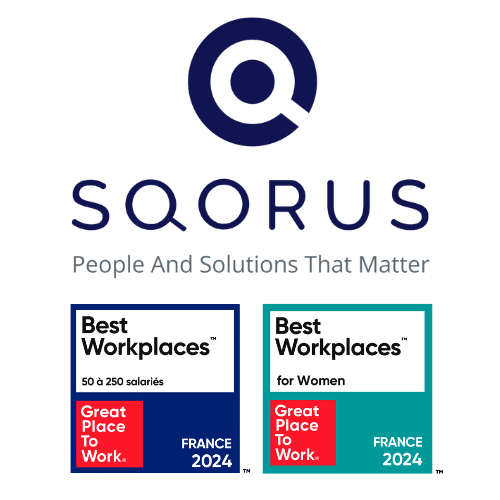Payroll is often a company’s biggest expense item. However, the associated social management control is at the crossroads between the Human Resources and Finance Departments.
Faced with rapid changes in the world of work, ever more rapidly evolving skills and new technological breakthroughs such as artificial intelligence, static, compartmentalized management is no longer sufficient.
So how do you transform this apparent constraint into a real driver of performance and agility for your company?
François BOUCHERY, HR Division Director at SQORUS, and Nicolas CUESTA, EPM Manager at Smarthys, reveal their strategy, which is based on a collaborative, decompartmentalized, tool-based approach.
Governance and collaboration: the prerequisites for success

François BOUCHERY
HR Division Manager at SQORUS
Social management control suffers from a deep-rooted organizational flaw: it straddles two departments with sometimes very different cultures, calendars and vocabularies. Finance, driven by monthly closings, and HR, based on business processes and the calendar month, struggle to align their visions.
This situation gives rise to practical difficulties: data scattered between multiple tools(HRIS, payroll, finance), absence of a single repository.
The main challenge is to establish clear, shared governance. This involves defining a common lexicon – there are, for example, many different ways of calculating a FTE (Full-Time Equivalent) – and strengthening collaboration.
The implementation of a management tool then becomes a powerful lever for realigning teams, harmonizing processes and guaranteeing the consistency of analyses. This is less a technological transformation than an evolution in collaboration methods, with a direct impact on the company’s overall performance.
The pillars of effective social control
Once the principle of collaboration has been established, how can social controlling be transformed into a strategic tool? To do this, we need to tackle the recurring ” pain points “, and change our perspective by building on solid foundations.
1. From reliable data to the right decision

Nicolas CUESTA
EPM Manager at SMARTHYS
The main obstacle to effective management is the dispersion and unreliability of data. Data entry errors, late updates and duplications create mistrust in the figures, and lead to endless manual reprocessing.
To get beyond this stage, the implementation of a Core HR is essential. It centralizes information and ensures its quality within a single repository.
It is on this healthy, up-to-date database that Enterprise Performance Management(EPM) tools are most relevant. The addition of an EPM solution solution natively connected to the HR Socle enables us to move away from an a posteriori reporting logic, which merely notes discrepancies, to proactive, forward-looking management aligned with real-time operational data.
You can then develop dynamic scenarios to accurately measure the impact of a recruitment plan, a collective pay rise, inflation or a redundancy plan. The company becomes more agile, and can anticipate regulatory, fiscal and social impacts before they become unavoidable constraints.
2. The “Who” vs “How many” duality

Nicolas CUESTA
EPM Manager at SMARTHYS
Efficient management cannot simply track costs. It must cross two complementary angles, because a decision on one has a direct impact on the other.
- Quantitative (the “Who”): managed by HR, this involves headcount, FTEs, status and skills. Not only does this enable us to anticipate job vacancies and contract terminations, it also enables us to carry out genuine forward-looking management of jobs and skills (GPEC). Which jobs are in short supply? What skills will we need in the future? Can internal mobility fill certain needs?
- Financial (the “How much”): steered by Finance, this corresponds to the direct and indirect costs of the workforce (fixed and variable remuneration, bonuses, social security charges, training costs, recruitment costs, etc.). This axis enables us to assess the financial weight of the human structure, and to analyze key factors such as the Noria effect (the financial impact of replacing an experienced employee with a junior, who is often paid less), or the GVT (Glissement Vieillissement Technicité) effect, which explains the natural increase in payroll at constant headcount.
These two dimensions are inseparable. A stable workforce can conceal a growing payroll. Conversely, a reorganization can reduce headcount while increasing costs if it requires the recruitment of highly sought-after expert profiles.

François BOUCHERY
HR Division Manager at SQORUS
The HR/Finance crossover approach enables us to build reliable scenarios and efficiently arbitrate between volume (how many people?) and value (at what cost?) according to the company’s strategic priorities: growth, optimization, transformation.
3. Capacity Planning
Capacity Planning is the concept that links operational HR management with overall corporate strategy.
Its aim is simple: to anticipate and plan the resources (human, material and financial) needed to meet the expected workload and, ultimately, achieve business objectives. It’s no longer just a matter of “filling in the blanks”, but of ensuring that the company has the capacity to deliver its projects, satisfy its customers or conquer new markets.
By matching demand (projects, order books, forecast activity) with capacity (available staff and skills), Capacity Planning enables fine-tuned social management control. It helps to anticipate the financial impact of recruitment plans, to manage the contractual mix (internal, external, freelance) and to integrate the effects of price (increases) and volume (hirings). It is the common language that provides a factual and constructive framework for dialogue between HR, Finance and operational staff, enabling decisions to be taken that are truly aligned with strategy.
The dual expertise strategy
At SQORUS, with our dual expertise in HR and EPM, we support companies in all aspects of social controlling.
Our teams get involved right from the scoping phase to define objectives and scope. This detailed understanding of the issues at stake is essential, and guides us every step of the way. We then take charge of solution implementation, project management and post-deployment support.
This end-to-end support promotes exchange and flexibility, ensuring that the tool deployed is not only high-performance, but also perfectly aligned with your operational realities.
Contact
A project? A request?A question?
Contact us today and find out how we can work together to make your company’s digital future a reality.





